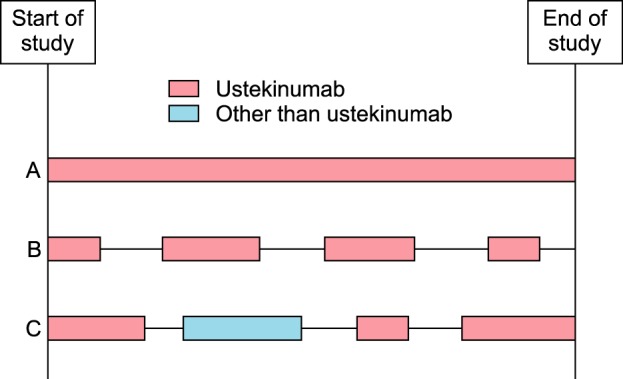Ann Dermatol.
2018 Apr;30(2):179-185. 10.5021/ad.2018.30.2.179.
Economic Burden Can Be the Major Determining Factor Resulting in Short-Term Intermittent and Repetitive Ustekinumab Treatment for Moderate-to-Severe Psoriasis
- Affiliations
-
- 1Department of Dermatology, Seoul National University Bundang Hospital, Seoul National University College of Medicine, Seongnam, Korea. swyoun@snu.ac.kr
- KMID: 2414679
- DOI: http://doi.org/10.5021/ad.2018.30.2.179
Abstract
- BACKGROUND
The continuous use of biologic agents in the treatment of psoriasis has been reported to result in successful and sustained therapeutic effects and safety. However, some patients choose intermittent and repetitive treatment.
OBJECTIVE
To determine the factors for selecting intermittent and repetitive ustekinumab treatment for the management of psoriasis.
METHODS
From January 2011 to October 2016, we enrolled 30 psoriasis patients who discontinued ustekinumab treatment and were followed up for psoriasis treatment. We reviewed data regarding patients' clinical characteristics and the treatment they received, and investigated the factors for selecting intermittent treatment.
RESULTS
A total of 52 ustekinumab treatment periods were administered to the 30 patients. Of the 52 treatment periods, 34.6% were covered by insurance and 82.4% were discontinued after sufficient improvement had been made or at the patient's request. Further analysis comparing the first and second ustekinumab treatments revealed that the patients who used ustekinumab in second treatment were more likely to be insured. In addition, the rate of patients reaching psoriasis area and severity index (PASI)75 and PASI90 was similar between the first and subsequent ustekinumab treatments.
CONCLUSION
We found that the patients who used ustekinumab intermittently were those who were satisfied with the outcome of ustekinumab treatment but could not afford the treatment. These results suggested that economic burden can be a factor for the patients' choice of short-term intermittent treatment. The expansion of insurance coverage can increase the effectiveness of, and patients' satisfaction with, the management of psoriasis.
MeSH Terms
Figure
Reference
-
1. Nickoloff BJ, Stevens SR. What have we learned in dermatology from the biologic therapies? J Am Acad Dermatol. 2006; 54(3 Suppl 2):S143–S151. PMID: 16488330.
Article2. Fragoulis GE, Siebert S, McInnes IB. Therapeutic targeting of IL-17 and IL-23 cytokines in immune-mediated diseases. Annu Rev Med. 2016; 67:337–353. PMID: 26565676.
Article3. Ramirez-Fort MK, Levin AA, Au SC, Gottlieb AB. Continuous versus intermittent therapy for moderate-to-severe psoriasis. Clin Exp Rheumatol. 2013; 31(4 Suppl 78):S63–S70. PMID: 24129141.4. Kimball AB, Gordon KB, Fakharzadeh S, Yeilding N, Szapary PO, Schenkel B, et al. Long-term efficacy of ustekinumab in patients with moderate-to-severe psoriasis: results from the PHOENIX 1 trial through up to 3 years. Br J Dermatol. 2012; 166:861–872. PMID: 22356258.5. Kimball AB, Papp KA, Wasfi Y, Chan D, Bissonnette R, Sofen H, et al. Long-term efficacy of ustekinumab in patients with moderate-to-severe psoriasis treated for up to 5 years in the PHOENIX 1 study. J Eur Acad Dermatol Venereol. 2013; 27:1535–1545. PMID: 23279003.6. Langley RG, Lebwohl M, Krueger GG, Szapary PO, Wasfi Y, Chan D, et al. Long-term efficacy and safety of ustekinumab, with and without dosing adjustment, in patients with moderate-to-severe psoriasis: results from the PHOENIX 2 study through 5 years of follow-up. Br J Dermatol. 2015; 172:1371–1383. PMID: 25307931.7. Shalom G, Cohen AD, Ziv M, Eran CB, Feldhamer I, Freud T, et al. Biologic drug survival in Israeli psoriasis patients. J Am Acad Dermatol. 2017; 76:662–669.e1. PMID: 28038888.
Article8. Youn SW, Tsai TF, Theng C, Choon SE, Wiryadi BE, Pires A, et al. The MARCOPOLO study of ustekinumab utilization and efficacy in a eeal-world setting: treatment of patients with plaque psoriasis in Asia-pacific countries. Ann Dermatol. 2016; 28:222–231. PMID: 27081271.9. Puig L, Ruiz-Salas V. Long-term efficacy, safety and drug survival of ustekinumab in a Spanish cohort of patients with moderate to severe plaque psoriasis. Dermatology. 2015; 230:46–54. PMID: 25572820.
Article10. Vergou T, Moustou AE, Antoniou C. Five-year experience with Ustekinumab for psoriasis: real-life data of a single centre. J Eur Acad Dermatol Venereol. 2017; 31:e40–e41. PMID: 27038363.
Article11. Gordon KB, Langley RG, Leonardi C, Toth D, Menter MA, Kang S, et al. Clinical response to adalimumab treatment in patients with moderate to severe psoriasis: double-blind, randomized controlled trial and open-label extension study. J Am Acad Dermatol. 2006; 55:598–606. PMID: 17010738.
Article12. Yeung H, Wan J, Van Voorhees AS, Callis Duffin K, Krueger GG, Kalb RE, et al. Patient-reported reasons for the discontinuation of commonly used treatments for moderate to severe psoriasis. J Am Acad Dermatol. 2013; 68:64–72. PMID: 22846688.
Article13. Menter A, Korman NJ, Elmets CA, Feldman SR, Gelfand JM, Gordon KB, et al. Guidelines of care for the management of psoriasis and psoriatic arthritis: section 4. Guidelines of care for the management and treatment of psoriasis with traditional systemic agents. J Am Acad Dermatol. 2009; 61:451–485. PMID: 19493586.14. Staidle JP, Dabade TS, Feldman SR. A pharmacoeconomic analysis of severe psoriasis therapy: a review of treatment choices and cost efficiency. Expert Opin Pharmacother. 2011; 12:2041–2054. PMID: 21736530.
Article
- Full Text Links
- Actions
-
Cited
- CITED
-
- Close
- Share
- Similar articles
-
- The use of biologics for severe psoriasis
- Economic Factors as Major Determinants of Ustekinumab Drug Survival of Patients with Chronic Plaque Psoriasis in Korea
- Long-Term Analysis of Ustekinumab Therapy for Moderate-to-Severe Psoriasis in Korea
- The Effect of Combination Treatment with Ustekinumab and Topical Agents in Korean Patients with Moderate-to-severe Psoriasis: A Retrospective Study of 30 Patients through 5 Years of Follow Up
- Safety of Adalimumab, Ustekinumab, Secukinumab, Guselkumab in Korean Patients with Moderate to Severe Psoriasis: A Real-World Data in a Single Medical Center


